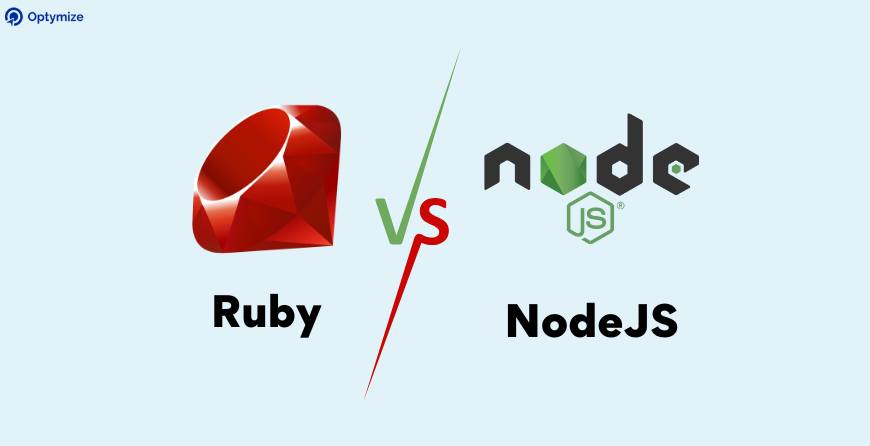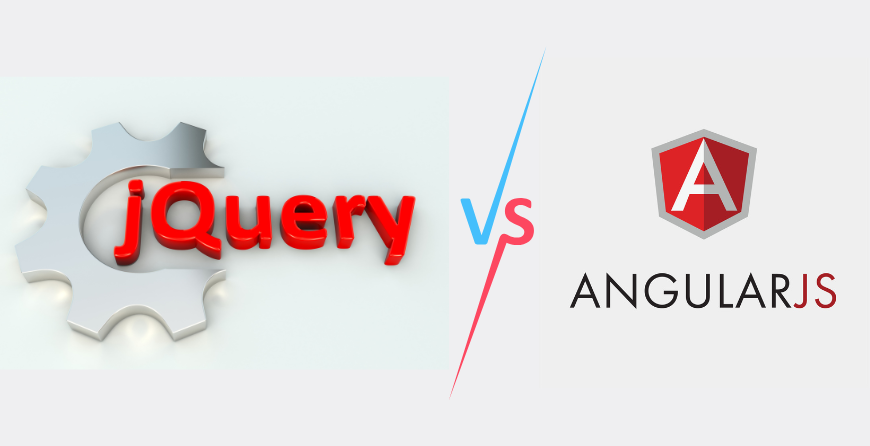Table of Contents
Introduction
The debate is on – Ruby on Rails vs Node JS: which one is superior for your product development?
When it comes to the front end, deciding the tech stack is not too difficult, as JavaScript, HTML, and CSS are the obvious choices, but if it’s the back end, then you have to choose the tools wisely.
In fact, backend technologies are more versatile and difficult to choose from. Recently, Ruby on Rails and Node JS have emerged as effective backend technologies.
While Node JS is a runtime environment that uses Javascript to create server-side applications, Ruby on Rails is a framework for building websites.
But which one is better? It’s normal to feel overwhelmed when selecting the right tool if you are not aware of their benefits; for this reason, we’ve come up with a solution.
We have combined our thoughts and experiences with Ruby on Rails and Node JS in this article, which includes both their benefits and drawbacks.
In short, this article will provide you with an in-depth comparison of Ruby on Rails Vs Node JS frameworks where you will get insights on their performance, architecture, their ideal use cases, and more, so read till the end, and find out which tool meets your project requirements.
Also Read: Ruby VS Python: A Head-to-Head Comparison
Ruby on Rails VS Node JS: Overview
Ruby on Rails

Ruby is a web development framework written in the Ruby programming language. It is made for building database-backed MVC-based CRUD applications and metaprogramming.
It was designed to aid in the management of internal logic, data computation, routines, and other tasks.
It adheres to the simple philosophy of DRY (don’t repeat yourself) and convention over configuration, which keeps the codes maintainable, extensible, and less buggy while reducing the hassles of manually configuring codes for different systems.
It is ideal for beginners because it is simple to learn and use. However, the best part of this framework is that it is rapid and code-efficient.
In short, while other languages execute the tasks in 50 lines, Ruby on Rails does it in 10 or 15. An experienced and highly skilled RoR developer knows how to follow the best coding practices for Ruby on Rails Development projects.
Read our extensive and updated guide to hire Ruby on Rails Developers in 2023.
Market share, Statistics, and Insights
According to SimilarTech Ruby on Rails
- > Powers over 410,000+ active sites on the internet
- > Leading in the top 1 million sites and the entire web
- > Is leading in over 135+ countries.
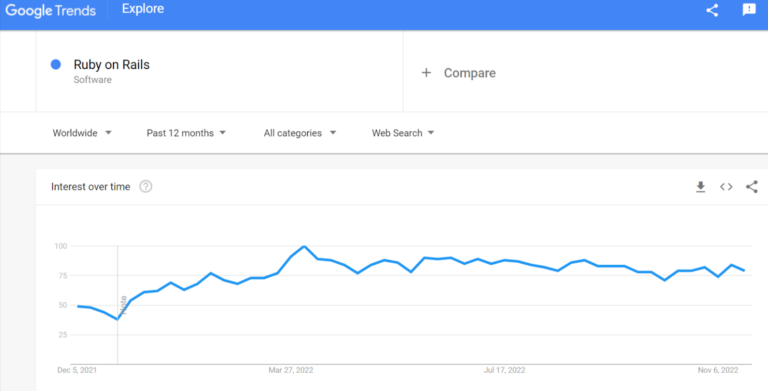
Google Trends data shows Ruby on Rails has been trending quite a lot; in fact, since COVID ended, Ruby on Rails has seen a sudden spike in usability among different industry verticals. Ruby on Rails can help you add more functionality to your services. Most of the services you use on a regular basis use some third-party API to enhance their functionality. Read our guide on how to build a Ruby on Rails API.
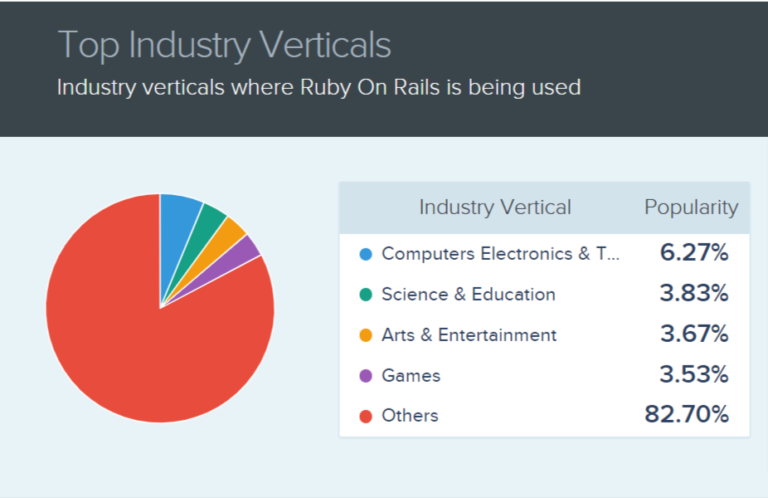
Image Credit: SimilarTech
Popular apps powered by Ruby on Rails:
- > GitHub
- > Airbnb
- > Slideshare
- > Bloomberg
NodeJS
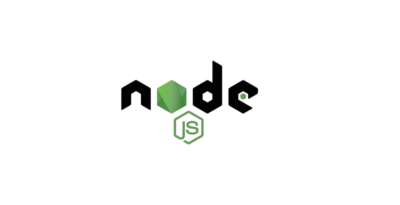
Many people are perplexed by the fact that Node JS is not a language.
It’s a popular asynchronous, event-driven JavaScript runtime environment for developing scalable server-side network applications.
Node changes JavaScript code into machine code, which can be easily interpreted by hardware.
Furthermore, Node includes a built-in Chrome V8 engine that speeds up rendering. You can hire a professional NodeJS developer for your backend development who knows the language at his tips.
Market share, Statistics, and Insights:
Let’s take a look at the Node JS market share details. Based on the data of SimilarTech, Node JS
- > Powers over 238,000+ active sites on the internet
- > Leading in the top 10k sites and 100k sites.
- > Is leading in over 20+ countries.
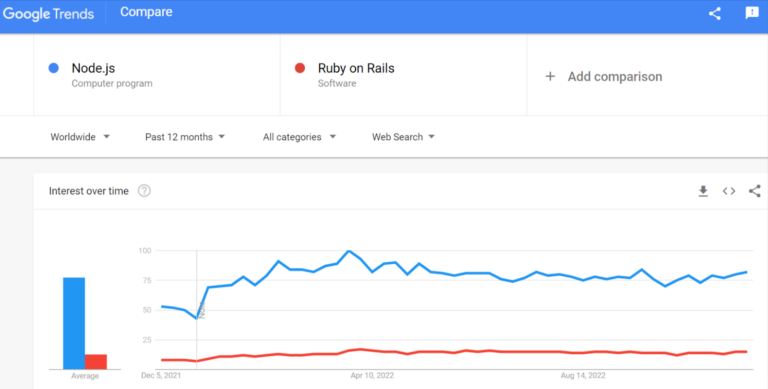
Similar to Ruby on Rails, Node JS has surged like any other web development tool. In fact, based on Google Trends data, it surpasses the popularity index of Ruby on Rails.
To support this statement, we have mentioned the Stack Overflow 2022 survey that suggests Node JS is the #1 web development framework that developers use.

Just like Ruby on Rails, Node JS is being used everywhere. Look at the image below to learn more about the industries that use Node JS.

Image Credit: SimilarTech
Popular apps powered by Node JS:
- > Trello
- > Netflix
Ruby on Rails VS Node JS Performance Comparison
Performance is a crucial factor when it comes to building large-scale web applications. It may not be important for small applications, but keeping the application fast and providing users with an interactive user experience is a priority. Let’s see how well Ruby on Rails and Node JS perform in terms of speed.
Ruby on Rails
Ruby on Rails is a prominent player when it comes to performance. It operates quickly and efficiently. Some parameters, such as its garbage collector and interpreted tool, slow down its performance, but this is a rare occurrence when the application receives a lot of traffic.
However, Ruby on Rails can undoubtedly create efficient web solutions with speedy performance in most cases. The only thing that should be monitored is its development standards, to ensure that everything goes as planned.
Node JS
Node JS is the perfect runtime environment for executing small tasks, thanks to its asynchronous operations and non-blocking capability.
These smaller tasks are executed within their premises and never affect their major thread, which significantly boosts its performance.
And if it is combined with the V8 JavaScript engine, multitasking becomes more efficient and speedy.
Ruby on Rails VS Node JS Scalability
Scalability is a method that advances any web application. The more the app is scalable, it is guaranteed that the growth of that domain and company will eventually reach greater heights. Let’s take a look at what methodologies Ruby on Rails and Node JS use to excel at scalability.
Ruby on Rails
When it comes to scalability, Ruby on Rails does require some external resources as compared to other backend technologies.
Due to the poor concurrency feature and insufficient memory management, scaling quickly with Ruby causes some issues.
Twitter was one of the applications that decided to go with another backend framework for quick scalability, and it became a matter of criticizing whether Ruby on Rails is capable of offering scalability.
However, apps like Airbnb and Shopify are perfect examples of how Ruby on Rails can scale quickly while handling high traffic.
You might need certified ROR developers who are dedicated and committed to providing you with top-notch Ruby on Rails experience for your projects. But you need to be sure of what essential interview questions you should ask so that you don’t end up hiring the wrong candidate. Well, don’t worry, we have got you covered. We have prepared an article to help you with 13 essential Ruby on Rails interview questions.
NodeJS
Node JS was designed to be highly scalable. Its non-blocking I/O and event-driven model handle multiple concurrent requests at the same time, and combined with its event-loop mechanism, the server processes maximum requests within a fraction of a second.
Moreover, Node JS divides every task into smaller chunks, causing speedy task execution regardless of the size of the app.
This way, Node JS efficiently manages each process, making it easy to allocate tasks among multiple teams and scale applications within a short period of time.
Ruby on Rails VS Node JS Application Architecture
Architecture is one of the most discussed parameters when it comes to choosing frameworks. Let’s find out what architectures Ruby on Rails and Node JS provide and how they compete with each other.
Ruby on Rails
Ruby on Rails is built on top of the MVC (model view controller) architecture. The model layer is where you set rules and put data logic. The view handles the front end, whereas the controller takes care of the flow.
This separation leads the architecture toward easier decoupling and effective testing at later stages. ROR follows its philosophy of “convention over configuration,” which implies the framework handles all the configuration parts to let developers focus more on the coding and logical parts.
NodeJS
Node JS has a single-threaded event loop architecture, which lets it handle multiple concurrent requests with high performance. You can also make use of the MVC/ MVP architecture pattern, which reduces application isolation and onboarding difficulties in the codebases of the applications.
Additionally, it supports asynchronous communication between various elements and generates various views of the same data.
Ruby on Rails VS Node JS Testing and Debugging
The only ways to resolve issues in codebases and other parts of applications are through testing and debugging. As a result, it is critical to determine whether both frameworks provide automated and built-in testing for error-free product development.
Ruby on Rails
There are built-in testing capabilities in Ruby on Rails, which makes it simple and effective to conduct testing and debugging operations within the framework.
When a developer starts creating models and controllers, Rails automatically starts producing skeleton test code.
This saves developers the trouble of writing and testing code on occasion. Moreover, its emphasis on best development practices also reduces complexities during the testing phase.
NodeJS
Similar to Ruby on Rails, Node.js provides robust testing and debugging capabilities with its rich ecosystem of third-party packages.
Various automated testing tools like Lab and Code, Jasmine, and AVA create solid testing capabilities for Node.js apps.
Moreover, developers can use testing libraries like Mocha, Jest, and Chai to offer a seamless, bug-free experience to their users.
Ruby on Rails VS Node JS Code Readability And Learning Curve
Code readability is important to understand what the code really does and how it executes. The simpler the codes, the easier they are to understand, which leads to a short learning curve. Let’s take a look at the readability and learning curve of both languages used by these frameworks.
Ruby on Rails
Ruby has great code readability, which means it’s easy to learn. Hence, this programming language and ROR frameworks turn out great for beginners who want to become a web developer.
RoR has a huge and active community, and people can get any information required to learn the framework from multiple tutorials and courses.
NodeJS
Node.js is also easy to learn and has a short learning curve. If the developer has a background in either C#, Java, or C then they can master this framework in no time.
This especially turns out great for developers with decent knowledge of JavaScript, as they won’t be wasting any time learning the language. JavaScript code is very clear and simple to read.
Ruby on Rails Vs Node JS Updated Version
To keep the languages competitive in the market, companies release new, updated versions with some exciting features, functionalities, and other bug fixes that improve their efficiency.
Ruby on Rails 7.0
The latest version of Ruby on Rails aims to enhance the web development process with some extraordinary features.
- > Encrypted database layer
- > Asynchronous Querying
- > Controller actions to the stream-generated files
- > Zeitwerks mode
- > Named Variants
- > Turbo and Stimulus
And more.
Node JS 18.0
The latest release of Node JS brings improved runtime operations, bug fixes, and features that enhance developers’ experience and usability.
- > Native Fetch API
- > Open SSL 3 Support
- > The experimental node: test module
- > Experimental web stream APIs
- > V8 Engine 10.1
- > Global APIs
- > HTTP Timeouts
And more.
Ruby On Rails Vs Node JS Salary And Hourly Rate
Let’s take a look at the convenience of hiring ROR and Node JS developers.
Ruby on Rails
With such a large community, it becomes easier to hire Ruby on Rails developers.
The average range for hiring ROR developers as dedicated or freelancing resources varies between $60 and $75 per hour in North America and $30 to $50 per hour in Eastern Europe. In Asian countries like India, it is $20 to $30 per hour.
However, if you are a developer, looking for ROR jobs, you can expect an average salary for ROR Developers of $120k in the USA, $88k in Eastern Europe, and $15k in Asia per year.
Related Post: Check out the hourly rates on Ruby on Rails Developers.
NodeJS
Node JS has seen a rising demand for developers, and companies certainly want their resources in check.
Hiring Node JS developers as dedicated or freelancing resources typically range from $75 to $90 per hour in North America and $40 to $65 per hour in Eastern Europe. In Asian countries such as India, it ranges between $20 and $35 per hour.
However, if you are a developer looking for Node JS jobs, you can expect an annual salary for NodeJS Developers of $110,000 in the United States, $60k in Eastern Europe, and $18k in Asia.
Related Post: Check out the hourly rates of NodeJS Developers.
Which Is Better Node JS Or Ruby On Rails? The Verdict!
If we take a look at every other aspect other than scalability, it’s easier to say that Ruby on Rails is far greater than Node JS. We have no doubts about Node JS’s capabilities, but if a project requires more processing power, then choosing Ruby on Rails is a wise decision. Because of its single-threaded operations, it can handle large images and complex operations while still providing faster execution.
However, as we said, if it comes down to scalability, Node JS can be useful because of its micro-operations that divide your entire project into smaller chunks, giving you quick scaling capability.
Ruby on Rails’ Best Use Cases
- > Web apps
- > MVPs
- > eCommerce apps
- > Social-networking apps
Node JS Best Use Cases
- > Streaming web apps
- > Complex SPAs
- > Microservices
- > IoT applications
- > Backends and servers
- > API Development
Conclusion
Ruby on Rails VS Node JS explained as previously stated. Both backend frameworks are superior at some points, but it totally depends on your project requirements.
If you have a project that is smaller and you want performance to be its primary advantage, then ROR might fulfill your needs with its rapid execution process.
However, if scalability is all you seek in your project and you want to grow your web app on a large scale then Node JS can help you with its micro-app building.

